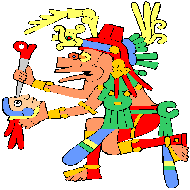Research Interests
 I find most
theory in computer studies boring, lifeless, and misleading
mostly because the assumptions backing it are seldom close to the
real world. Improper assumptions cause most theory to mislead one
into believing that something which is relatively simple is
difficult or impossible. This property usually comes from the
finite nature of real computation as opposed to the infinite
domain postulated by most theorists. I prefer to keep my research
grounded in the finite world, using theory to help, not hinder,
the creation of ideas.
I find most
theory in computer studies boring, lifeless, and misleading
mostly because the assumptions backing it are seldom close to the
real world. Improper assumptions cause most theory to mislead one
into believing that something which is relatively simple is
difficult or impossible. This property usually comes from the
finite nature of real computation as opposed to the infinite
domain postulated by most theorists. I prefer to keep my research
grounded in the finite world, using theory to help, not hinder,
the creation of ideas.
My main research interests are listed below:

Reliable Representation of Knowledge
I began work on a system to help one create
reliable knowledge in 1985. Reliable knowledge is an relative
notion, rather than an absolute one. One gains confidence in data
as progressive checks are made to the data. A series of
consistency checks, both internal and external on the data
provides more and more confidence in the data. Thus as the data
is filtered by each consistency check and errors are discovered
and corrected, the data itself becomes more reliable and
trustworthy. The invariants associated with the consistency check
become data characteristics allowing reasoning within the domain
of the consistency check.
While complete consistency checking is not
possible, this successive partial checking of independent models
is an important way to validate the data. The more models that
can be applied to the data the more reliable the data can be
made. This same idea could be applied to computer programs as
well, to insure correct programs.
A flexible form for recording unqualified facts
has been defined. Facts can look like written English which are
examples of particular relationships in an entity/relationship
model, with a subject being related by to zero or more object
entities by some relations.
For example: `Ophelia is a female.' In
which `Ophelia' is the subject entity, and there are no
object entities. Thus, relations which don't involve object
entities provide attributes for the subject.
Another example: `Ophelia gave her flowers
to Hamlet.' `Ophelia' is the subject entity, `her flowers'
and `Hamlet' are object entities, and `gave ... to' is the
relation.
A series of Unix filters for manipulating and
checking facts written in this form has been created. This system
is called Factotum. Using it researchers can create their
own formal models of data by specifying the syntax of relations,
the types of entities, and the meaning of relations in terms of
pre-existing paradigms. This formal model is described using
Factotum facts, in a standard form, which are interpreted by the
filters which do the checking of the data.
Over the years since 1985 when I started,
Factotum, has gained in power and flexibility. It is still an
experimental system in the sense that it has no unified user
interface, couplings between filters are ad hoc, and it only
works on Unix systems.
Current plans include the following:
- Create a facts to html filter to allow
hypertext viewing and publishing of the Factotum data.
- Design a unified user interface for
entering data.
- Create a series of display tools so one
can see the big picture.
- Add statistical tools for building
automated taxonomies of the data.
- Add statistical tools testing hypotheses
about data.
- Create new paradigms for checking data.

Hashing, Random Numbers and Encryption
In building the Factotum tools I discovered
that I needed a better hash function than the one I was using. To
my surprise it is possible to build a general hash function, one
that works on any domain and produces a uniform random
distribution of hash values. Theory says this is impossible.
However it is clear that noise is a relative notion, that is an
algorithm that produces random bits that are independent of the
keys that are to be hashed will add sufficient information to
mask all the information contained in the keys, the result is a
random uniform distribution.
There is no theory to predict how well this
will work and how many keys can be hashed using this technique
before the information in the keys begins to show through. I
currently have a PhD student working on trying to build a model
which will quantify this performance.
Empirically, however the performance of the
hash function is impressive and independent of domain. The
C-soure code for 'buzhash' for use on a 32-bit computer is small
and suitable for use in a library. There is also a 50 page
technical report from the University of Hong Kong called `General
Hashing' which describes the development of the buzhash function
and gives empirical results, it comes as a very large post-script
file, don't down load it unless you really want it. There is also
a 20 page technical report from the University of Auckland
describing `Hashing Myths'.

Human-Computer Interface
Programming Languages were the human-computer
interface of the 1950s 60s and 70s. The experimental principles
tested in those years provided some successes and many failures.
In the 1980s and 90s graphic user interfaces have become common
and new principles need to be developed. This new development
should not take place without looking at the lessons of the past.
Much of the recent research into human-computer
interfaces is led by psychologists who have become interested in
computer science and are trying to apply what they learned in
psychology to a new area. They are not well founded in computer
science formalisms and principles. Often they approach the
problem more as a psuedo-science than as a science. Generally
this psychology based computer science research has resulted in
failure and intellectual fatuation. This area of research is
essential to computer progress and good clean academic work needs
to permeate it.
At UCLA during the period 1979 to 1981 my
research group made a concerted effort to identify, classify and
develop methods for presenting high level language diagnostic
information. As a test bed the group instrumented several
compiler's so that we could determine how programmer's responded
to kinds of diagnostic messages. We instrumented Calgol, PL/C,
and other compilers.
The analysis of results were discouraging. We
discovered that after a short period of adjustment the form of
diagnostic had little effect on the number of program submittals
necessary to accomplish a programming task. This was because
humans quickly learn to understand even the most misleading
diagnostics and quickly solve most bugs.
Almost every program contained a persistent
error; an error which recurred job submittal after job submittal.
Examination of these persistent errors yielded no single cause
nor was it associated with some single type of diagnostic. Rather
the problem usually came about because of a mis-conception of the
progammer's interpretation of the semantics of the program he had
written. Until the misconception was resolved he continued to try
random changes to the code. Even if the error was isolated to a
single statement. Sometimes the programmer would even read his
own code, not as it was written, but as he expected it to be
written. So that even with the awareness of exactly where the
error was it took a long time to find.
This study convinced me that debugging systems
do little to improve productivity. It also made clear the
necessity of extensive practice in programming if one is to be
become a productive programmer. This practice is something a
university education never encourages or even offers as an
alternative. Universities promote ideas and understanding not
expertise.
Applied to human-interface problems today the
research we did with programming language diagnostics tells me
that fuzzy systems are liable to cause more disasters than they
will ease life for users. Good simple semantics that a user can
assimilate and will lead him through the computer interaction
will finally be seen as essential to good design.

Graphics and Animation
In 1981, at UCLA, I designed, developed, and
over the next three years built a system to do realistic computer
animation called Glinda. Glinda was written in C under UNIX.
Glinda used new multi-rendering techiques to create pictures. It
also distributed rendering across a large number of networked
mini-processors and reassembled the results into an animated
picture.
In 1984 Glinda was used to create a five minute
section of animation for a documentary film about Mexican
culture. This involved the creation of a 3D model of Mayan/Aztec
temple sites near Mexico City; recreating their appearance as
they were half a millinenum ago.

Data Structures and Data Retrieval Algorithms
From the very beginning of my involvement with
computing I have always been interesed in data structures and
algorithms for the fast retrieval of data. In the 1970 I began
work on designing efficient retrieval algorithms for data
structures in two level memory, that is primary and secondary
storage. This led to several papers with Richard Muntz and Rob
Matthijsen. In the 1970 Muntx/Uzgalis article on how to store
binary trees in two level memory, preceeded B-trees by many years
and for many applications provides better all-over performance.
Later in the 1970s I developed a method for
searching linked lists in square root time by making a trivial
change to the node allocation method. These a called wholesale
linked-lists. In 1995, Matthew Tong simulated the method and with
me wrote it up in a technical report for the Computer Science
Department at the University of Auckland.
With the work on general hashing Matthew and I
are close to achieving an ideal primary/secondary storage
retrieval system. However the understanding and modeling of
general data structures in secondary storage is still in its
infancy.
© Copyright 1996 Robert Uzgalis. All Rights
Reserved.
 I find most
theory in computer studies boring, lifeless, and misleading
mostly because the assumptions backing it are seldom close to the
real world. Improper assumptions cause most theory to mislead one
into believing that something which is relatively simple is
difficult or impossible. This property usually comes from the
finite nature of real computation as opposed to the infinite
domain postulated by most theorists. I prefer to keep my research
grounded in the finite world, using theory to help, not hinder,
the creation of ideas.
I find most
theory in computer studies boring, lifeless, and misleading
mostly because the assumptions backing it are seldom close to the
real world. Improper assumptions cause most theory to mislead one
into believing that something which is relatively simple is
difficult or impossible. This property usually comes from the
finite nature of real computation as opposed to the infinite
domain postulated by most theorists. I prefer to keep my research
grounded in the finite world, using theory to help, not hinder,
the creation of ideas.


